15 Best Workout Apps For Women in 2025
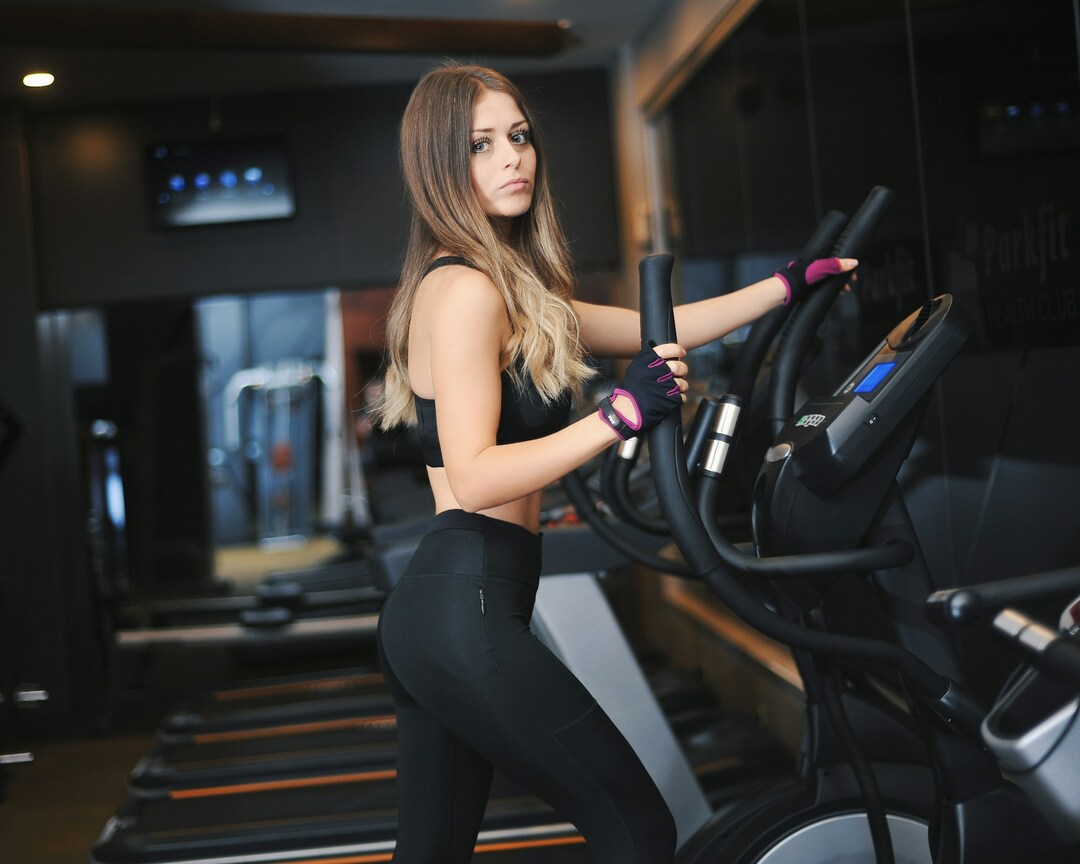
Discover the 15 best Workout Apps For Women in 2025, track progress, stay consistent, and reach your fitness goals with tools made for you.
Finding the right Workout Apps For Women can feel like scrolling through an endless feed when you juggle work, family, and shifting energy. With options for guided strength, HIIT, yoga, cycle aware training, and nutrition tracking, it is easy to lose sight of what truly fits your routine.
This article highlights the key features that matter: personalization, progress tracking, community support, and short home workouts so you can feel empowered and confident in selecting the perfect workout app tailored to your unique fitness goals, lifestyle, and preferences. What matters most to you: a live coach, customizable plans, or quick sessions you can do anywhere?
GetFit AI’s AI fitness app answers that question by building plans around your goals and schedule, offering cycle-aware and postnatal options, tracking progress, and suggesting workouts like strength, Pilates, and short cardio sessions so you can choose with confidence.
Summary
- Workout apps are now the primary modality for many women, with over 70% preferring apps for their fitness routines, which shifts competition from sheer class volume to personalization and user experience.
- Time efficiency is decisive: the average woman spends 45 minutes per day using workout apps, so programs that deliver measurable stimulus within 20 to 45 minutes consistently outperform long-format content.
- Measurable progression drives retention, as 65% of women reported improved fitness after three months of app use, showing that structured progressive overload plus adherence produces real gains.
- Motivation spikes matter, but do not replace programming, with over 70% reporting increased motivation from apps, yet users who do not sustain at least three sessions per week typically lose momentum and plateau.
- Apps can cause harm without guardrails: 75% of users felt pressured by unrealistic goals set by apps, and 60% reported increased anxiety due to constant notifications; therefore, notification hygiene and goal limits are essential.
- Privacy and integration determine long-term trust, especially since women make up nearly 60% of fitness app users and app usage rose about 30% in 2025, making exportability, plain-language policies, and reliable sync critical to prevent churn.
- This is where GetFit AI's AI fitness app comes in; it addresses these needs by creating adaptive, cycle-aware plans tailored to schedules, tracking progressive overload, and offering clear data export and privacy controls.
15 Best Workout Apps For Women in 2025
These 15 apps cover every practical approach women want in 2025, from studio-style live classes to data-driven, athlete-authentic coaching. The right choice comes down to your goals, schedule, and what you value most: personalization, community, or measurable performance. I’d place GetFit AI at the high end of the personalization curve because its athlete-sourced programs, combined with conversational coaching, enable users to access elite-level programming and feedback without needing to hire a private coach.
1. GetFit AI

GetFit AI is one of the best workout apps for women in 2025, offering an innovative fitness experience powered by artificial intelligence. The app utilizes advanced AI Body Scan technology to analyze your physique from a simple photo instantly, assessing factors such as gender, age, height, and weight. Based on this analysis, combined with your profile inputs, GetFit AI generates fully personalized workout routines and nutrition plans tailored to your unique body and goals, whether you aim to lose weight, build muscle, or improve overall health.
GetFit AI also stands out by allowing users to train with virtual versions of legendary athletes, such as Serena Williams, and offering motivational chat and workout customization inspired by their routines.
Features
- Instant AI Body Scan for personalized analytics
- Custom daily workout routines adjust with progress
- Tailored nutrition plans with meal guidance and recipes
- Progress tracking, including photos and measurements
- Interactive workout guides with exercise form correction
- Secure data handling with encrypted transmission
- Suitable for beginners to advanced fitness levels
Pros
- Personalized workout plans created via AI Body Scan to suit individual body metrics and goals.
- Real-time workout adaptations based on progress and feedback for continual challenge
- Integrated nutrition planning with detailed portion and recipe guidance
- Virtual training with AI renditions of famous athletes for motivation
- Comprehensive tracking of fitness activity, ensuring objective progress insights
Best For
- Women seeking a fully customized fitness and nutrition app
- Users wanting AI-driven, adaptive workout programming
- Those motivated by celebrity-inspired virtual coaching
- Women prefer a holistic health app combining exercise and diet
- Beginners looking for an easy setup and progress tracking
2. EvolveYou
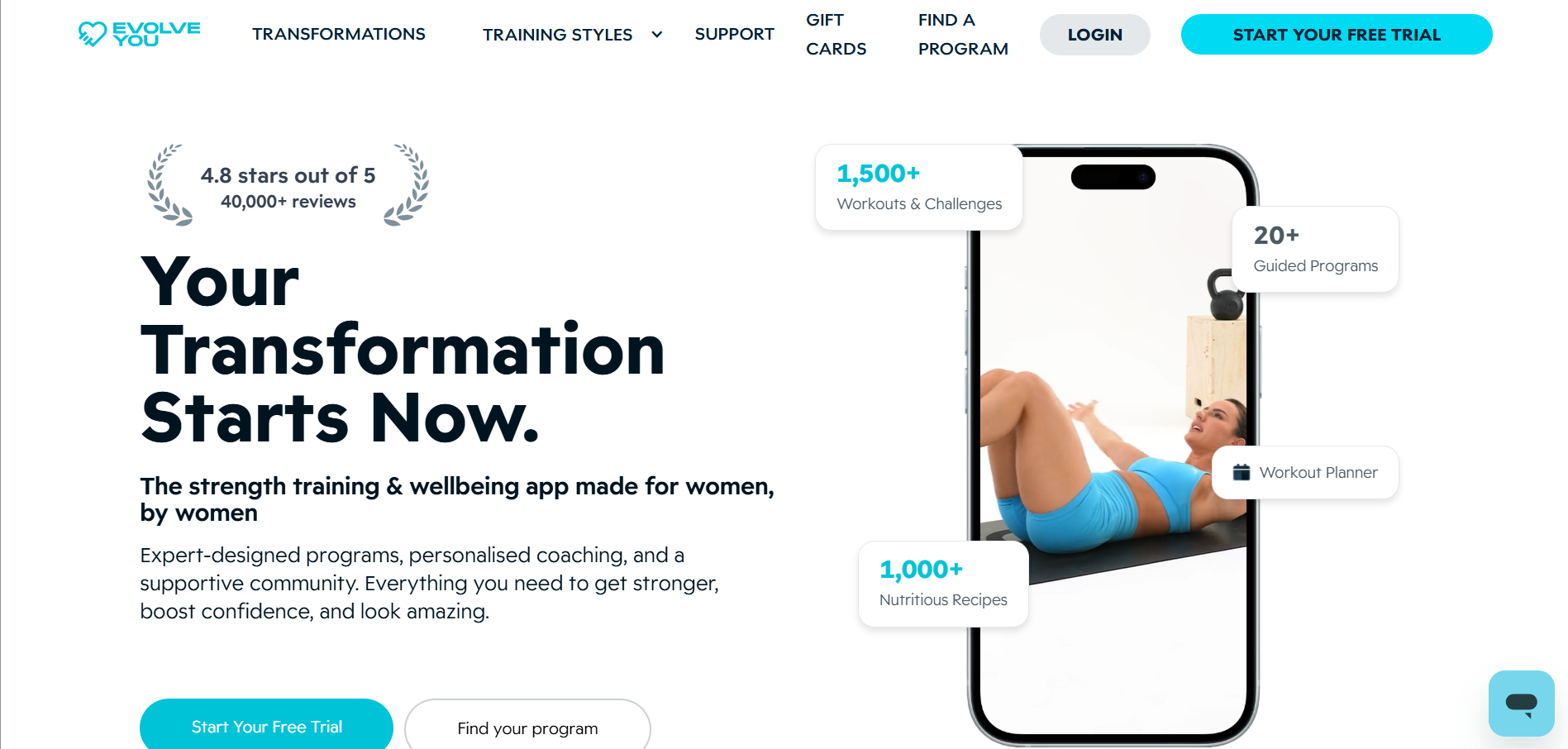
EvolveYou, formerly known as Tone and Sculpt, stands out for its fully customizable workout plans tailored to individual fitness goals and preferences. It allows users to select coaches with diverse specialties, from strength training and endurance to barre and yoga. You control the workout frequency, level, and whether you train at home or in the gym.
Features
- Customizable workouts (trainer choice, frequency, level, and location)
- Nutrition planning with four diet options
- Weekly dashboard and workout planner
- Short videos demonstrating exercises
- Meal tracking with recipes and shopping lists
3. Stronger By The Day
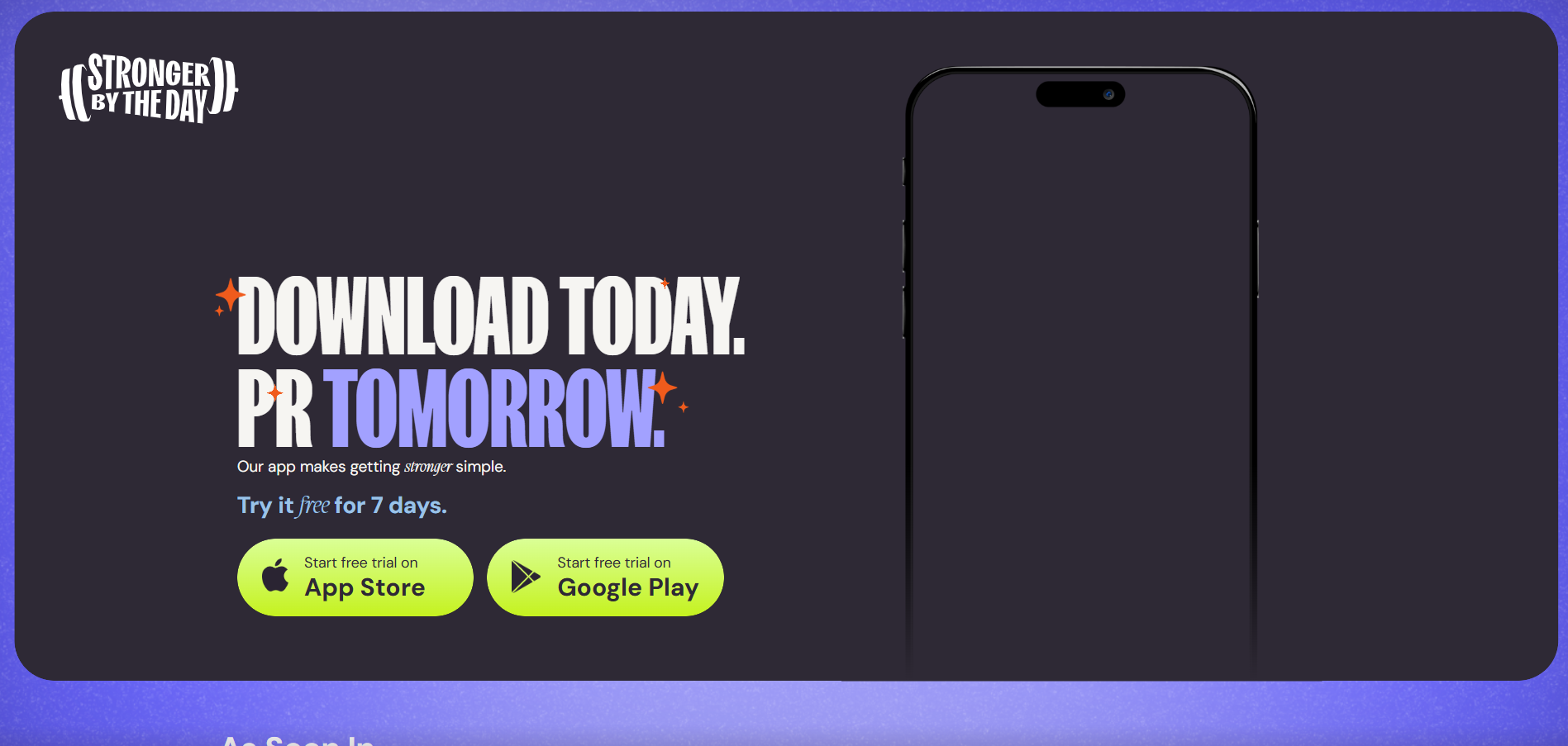
Created by powerlifting coach Meg Gallagher, Stronger By The Day targets women dedicated to increasing strength using science-based programming. The app offers five weekly workouts emphasizing lower and upper body strength, with options tailored to gym, bodyweight, or express sessions. Exercises come with video demos and warm-ups, and users can substitute based on equipment availability.
Features
- Science-backed strength workouts (five per week)
- Workout journal to log weights and reps
- Exercise substitutions for equipment/accessibility
- Conditioning workout add-ons
- Educational videos on nutrition and breathing
4. Melissa Wood Health (MWH)
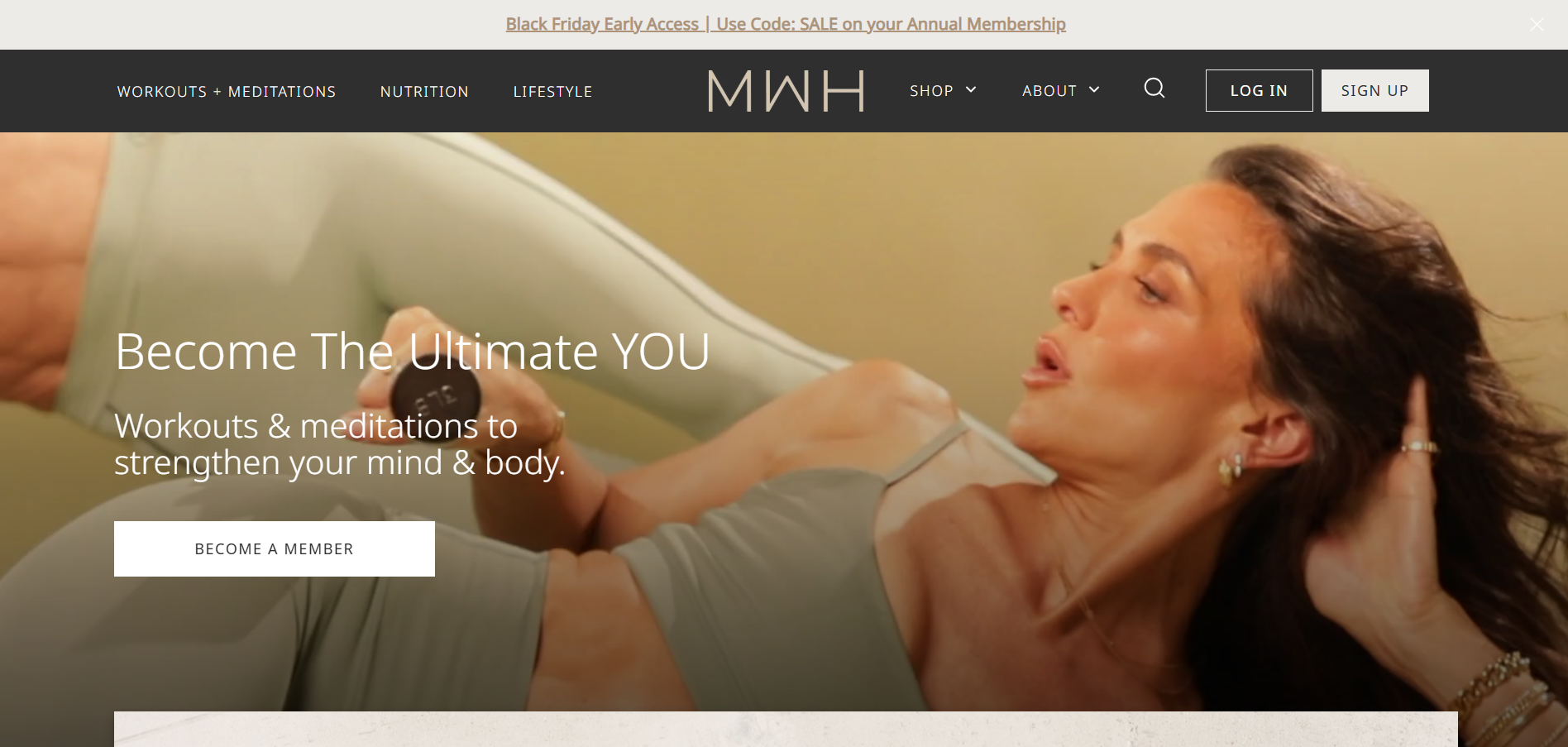
Melissa Wood Health’s app focuses on low-impact, mindful movement combining Pilates and yoga to create lean, strong muscles. Its workouts, ranging between 10 and 30 minutes, emphasize controlled motion and intention setting for a balanced body and mindset. New workouts are released weekly, including options for pre/postnatal care and meditation.
Features
- Low-impact Pilates and yoga workouts
- Intentional, mindful movement practices
- New workouts added weekly
- Guided meditation and specialized routines (prenatal, beginner)
- Inclusive for all fitness levels
5. StrongHer
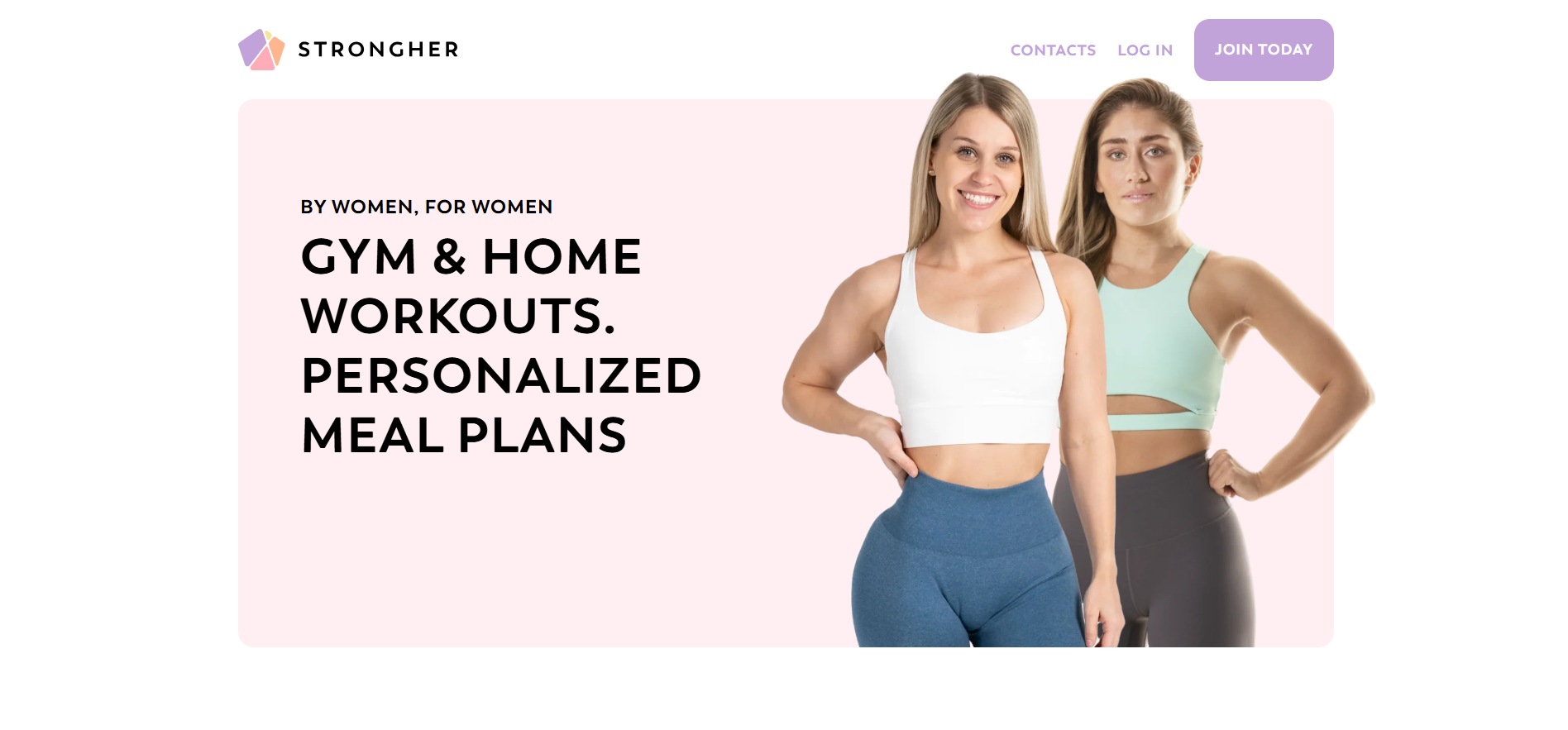
StrongHer, launched by Melissa Chalmers, combines fitness training with personalized nutrition planning to help women build muscle and achieve a toned physique. Users set goals and preferences (workout location, style, and nutrition type), then receive a tailored workout regimen alongside meal plans that are customizable to standard, keto, or vegetarian diets. Vegans can adapt vegetarian plans accordingly.
Features
- Personalized workout and nutrition plans
- Weekly workout updates
- Progress tracking (weights lifted, calorie/water intake)
- Point-based food tracking system
- Nutrition customizable for vegans, keto, and vegetarian diets
6. Alo Wellness Club
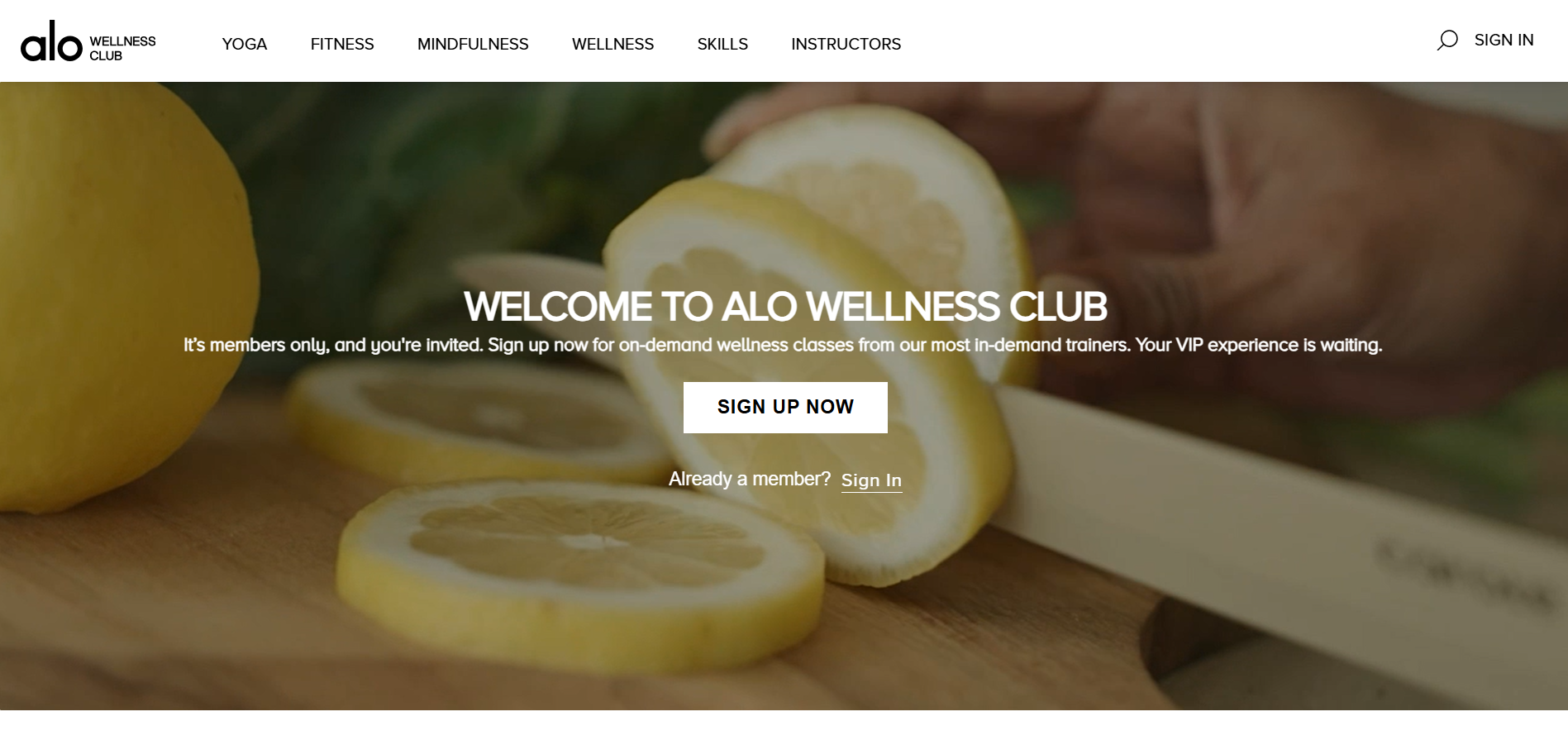
Alo Wellness Club, from Alo Yoga’s parent company, offers an extensive variety of classes that span yoga, Pilates, strength training, barre, sculpting, HIIT, and wellness content on nutrition and self-care. It suits users seeking a studio-class experience at home with classes tailored to moods and energy levels. Popular series include Gut Health and the Hour Glass Method, which blend fitness with digestive health and approachable strength training.
Features
- Wide-ranging classes (yoga, barre, HIIT, pilates, strength)
- Wellness content (nutrition, self-care, meditation)
- Tailored class recommendations
- Varied teaching styles for different energy levels
- Studio-like experience with flexible pacing
7. Sweat
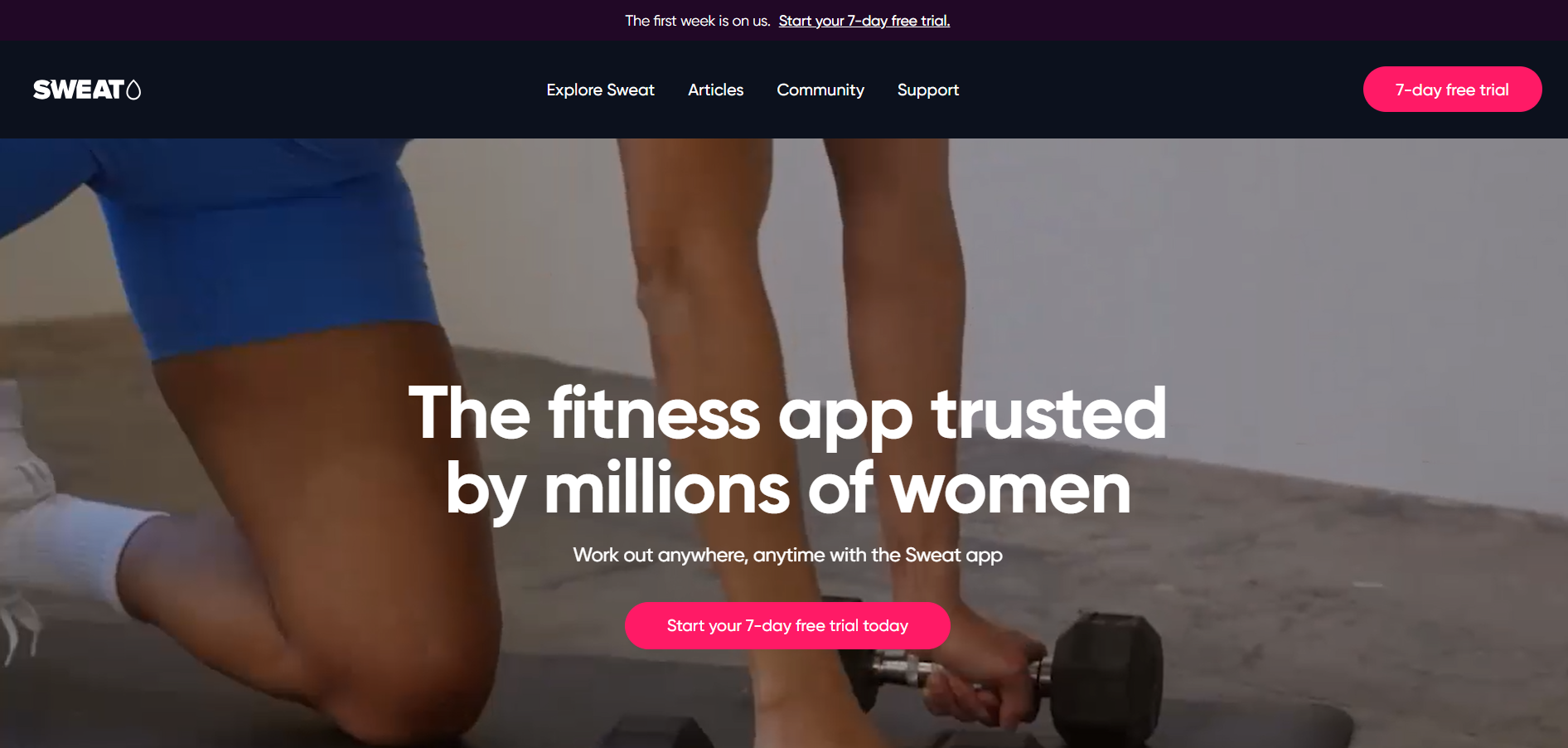
Sweat, founded by fitness icon Kayla Itsines, is designed for seasoned trainers who seek a range of high-intensity programs. It boasts over 30 different plans, including at-home workouts, post-pregnancy programs, gym training, and zero-equipment routines. The app uniquely integrates Spotify and Apple Music, allowing personalized playlists during workouts. It offers alternative exercises for varying skill levels and custom weekly plans.
Features
- Over 30 customizable workout programs
- Music integration with Spotify and Apple Music
- Alternative exercises for different skill levels
- Custom weekly workout planner
- Nutrition plans with recipes
8. Obé Fitness
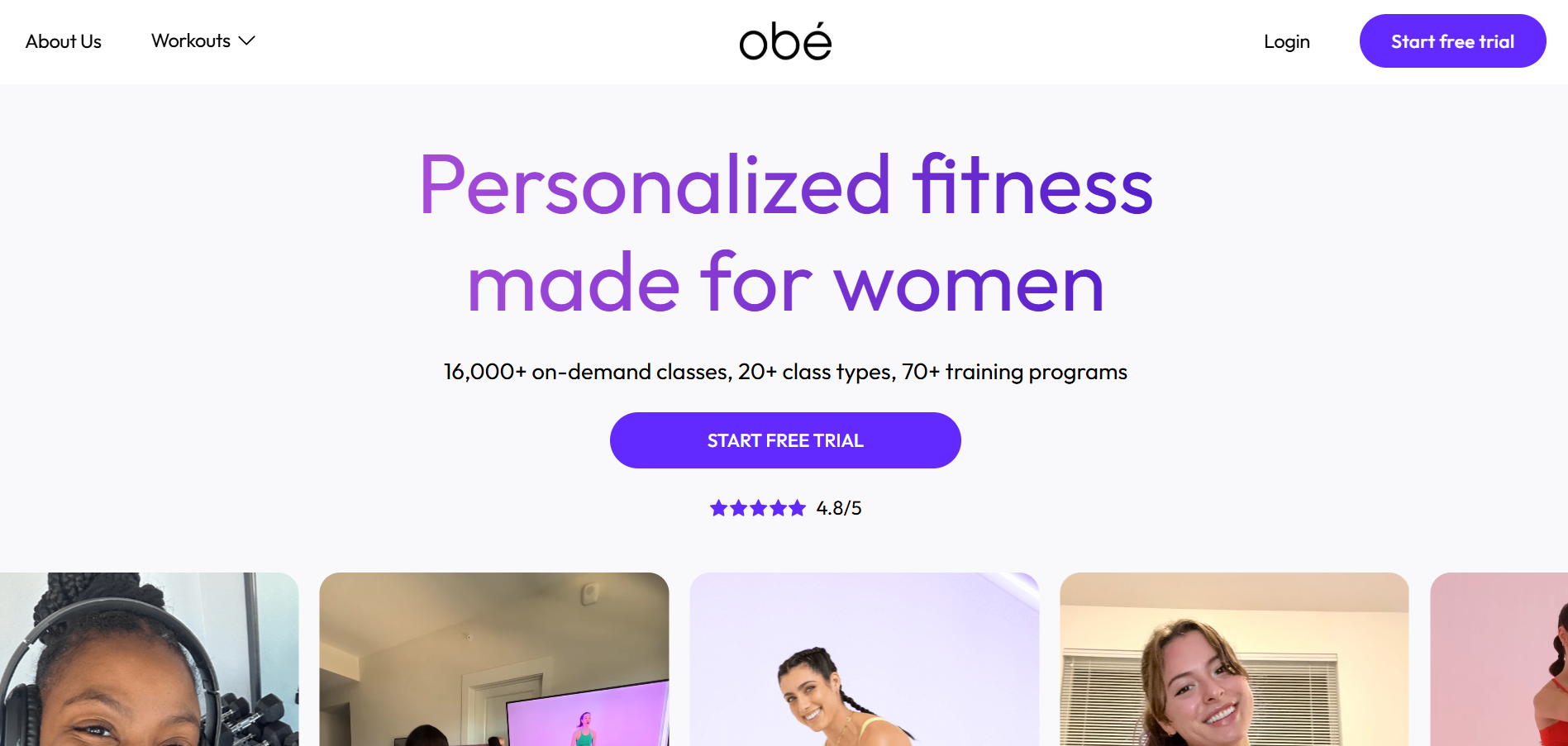
Obé Fitness offers an engaging experience with live and on-demand interactive classes across various categories, including barre, HIIT, dance, Pilates, and strength training. The vibrant community and motivated instructors make workouts fun and social. Classes vary in length and intensity, allowing you to pick what suits your schedule. The app supports integration with Apple Watch for real-time stats. Obé's lively classes are perfect for women who thrive on interactivity and variety.
Features
- Live and on-demand classes
- Diverse workout styles (dance, barre, HIIT, pilates)
- Community engagement and motivation
- Apple Watch integration
- Flexible class lengths and intensities
9. Ladder

Ladder combines intense workout sessions with personalized coaching from real trainers, giving users an in-depth fitness experience. After selecting a team based on your goals and preferred style (such as strength or Pilates), you receive over five fresh workouts each week from your coach. The app features on-demand programming, demo videos, and in-ear coaching for guidance. It offers a diverse roster of over 10 coaches, catering to all fitness levels and abilities.
Features
- Multiple coaching teams based on fitness goals
- Weekly release of new, coach-led workouts
- On-demand classes with demo and in-ear coaching
- Music integration and progress tracking
- Chat and feedback with trainers
10. YogaRenew
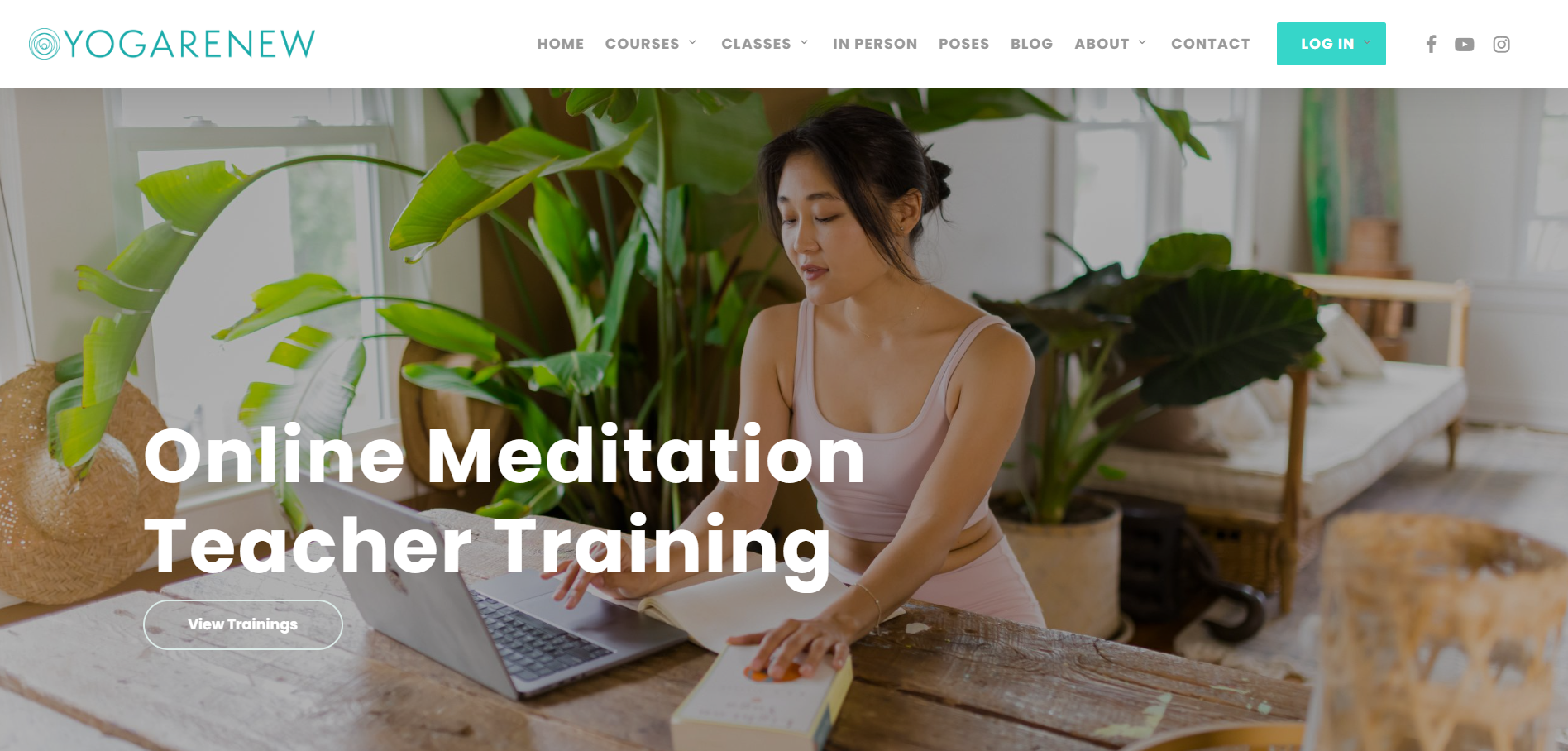
YogaRenew excels for yoga enthusiasts who prefer a calming, mindful approach. It streams over 1,000 live virtual classes, featuring diverse styles such as vinyasa and restorative yoga. The app is beginner-friendly, offering a variety of class lengths and intensities alongside guided meditation and breathwork sessions. This combination helps users relax before or after practicing postures like a child's pose.
Features
- Extensive live yoga classes in multiple styles
- Guided meditation and breathwork
- Variety of levels, intensities, and class lengths
- Beginner-friendly interface
- Available on Android and iOS
11. Strava
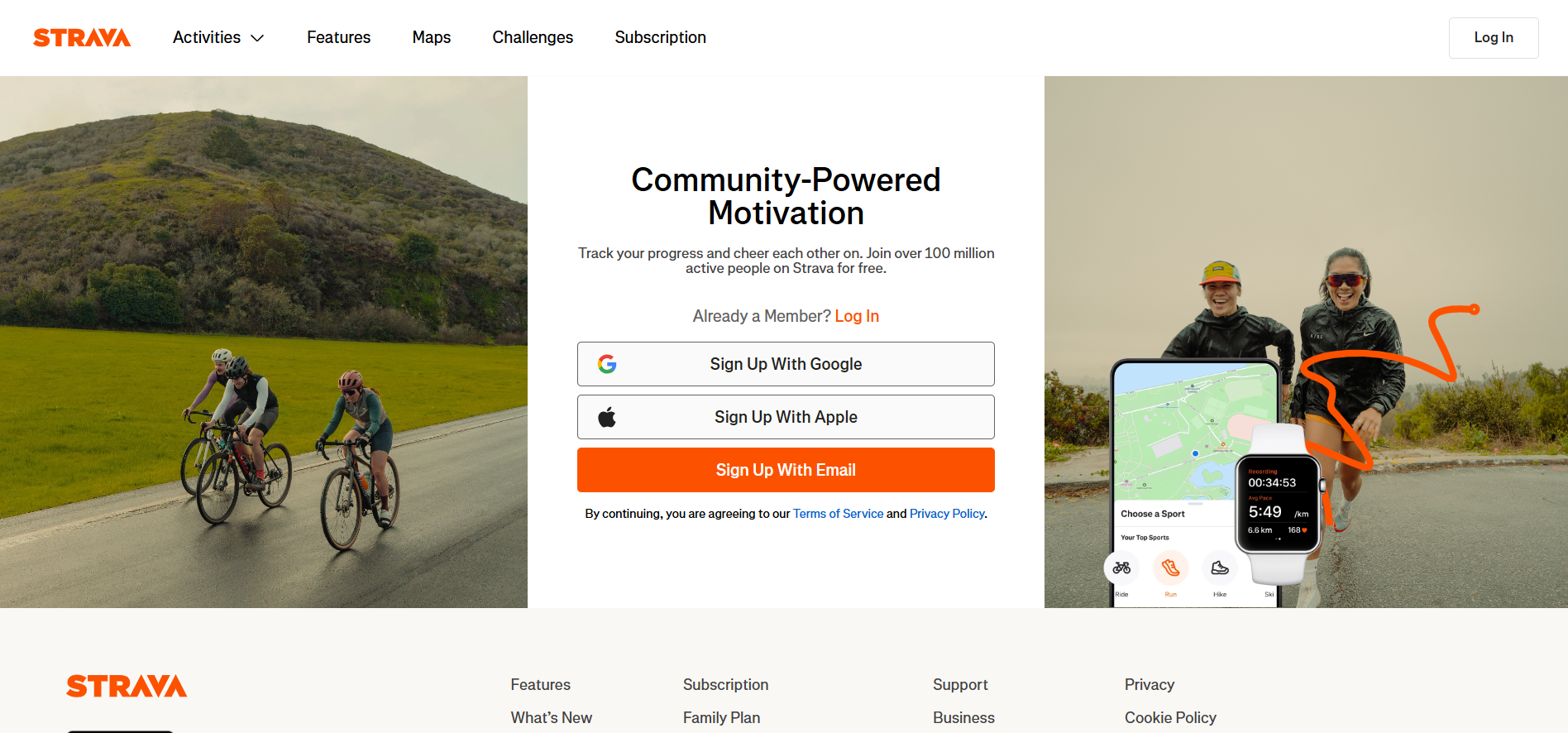
Strava is a favorite among active users who want to track a diverse range of workouts, including running, cycling, walking, strength training, and even niche sports like canoeing and kitesurfing. It centralizes all your fitness data and provides insights into pace and progress, which helps maintain motivation. Strava also supports setting weekly goals and analyzing performance trends, making it invaluable for both casual exercisers and dedicated athletes.
Features
- Tracks various sports and workouts
- Insights and pacing analytics for runners
- Integration with fitness trackers
- Set weekly fitness goals
- Access to popular routes and community features
12. WH Digital
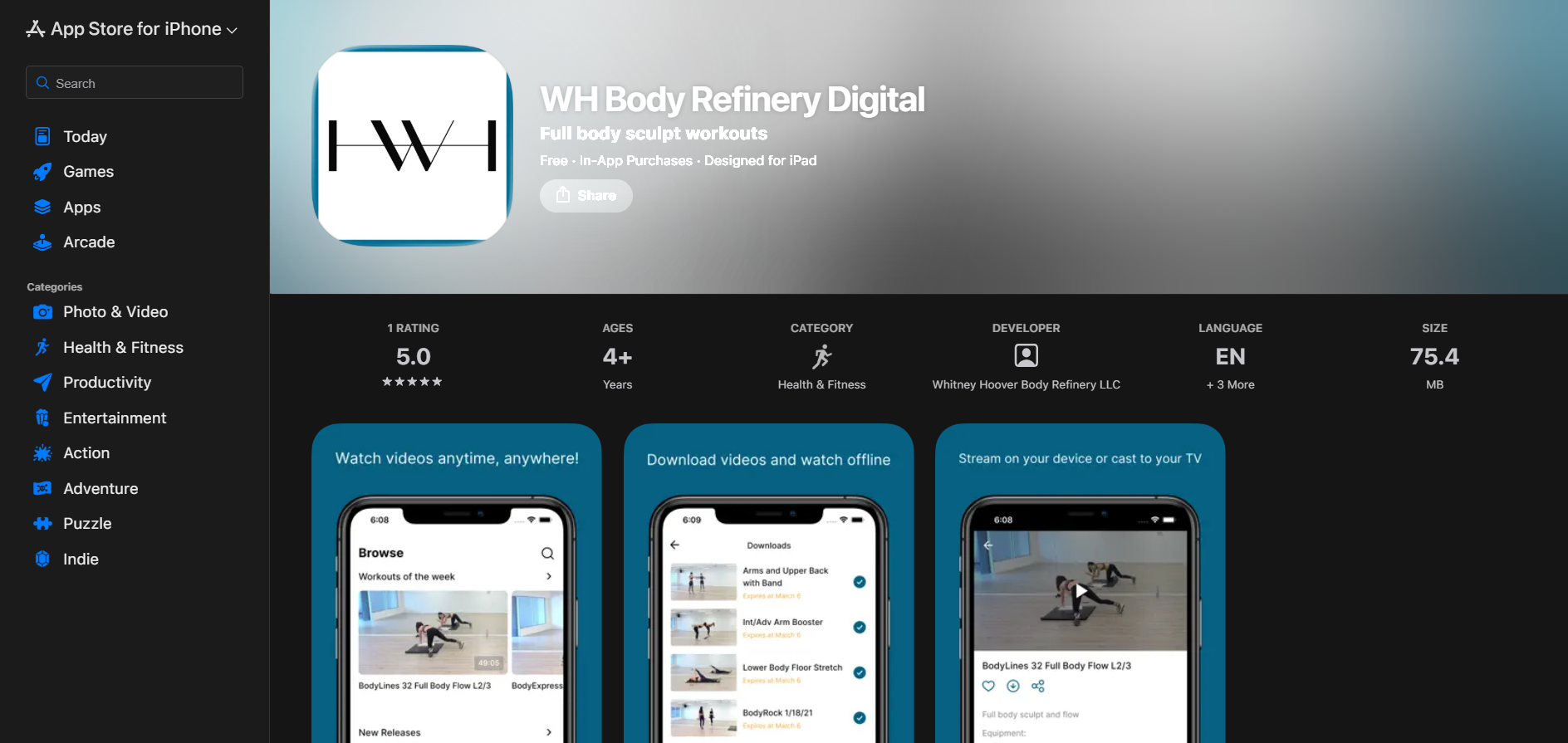
WH Digital aggregates premium workout programs from top trainers featured in Women’s Health alongside content from Men’s Health, Prevention, and Runner’s World. With over 100 workouts spanning bodyweight training, HIIT, yoga, meditation, dance cardio, and barre, the app offers a wide variety to suit any preference. New programs are regularly added, keeping the routines fresh and engaging.
Features
- Extensive catalog of curated workouts from expert trainers
- Diverse workout types, including strength, yoga, cardio, and barre
- New programs monthly
- Courses containing multiple videos for flexible timing
- Designed for sharing with others
13. Evlo Fitness
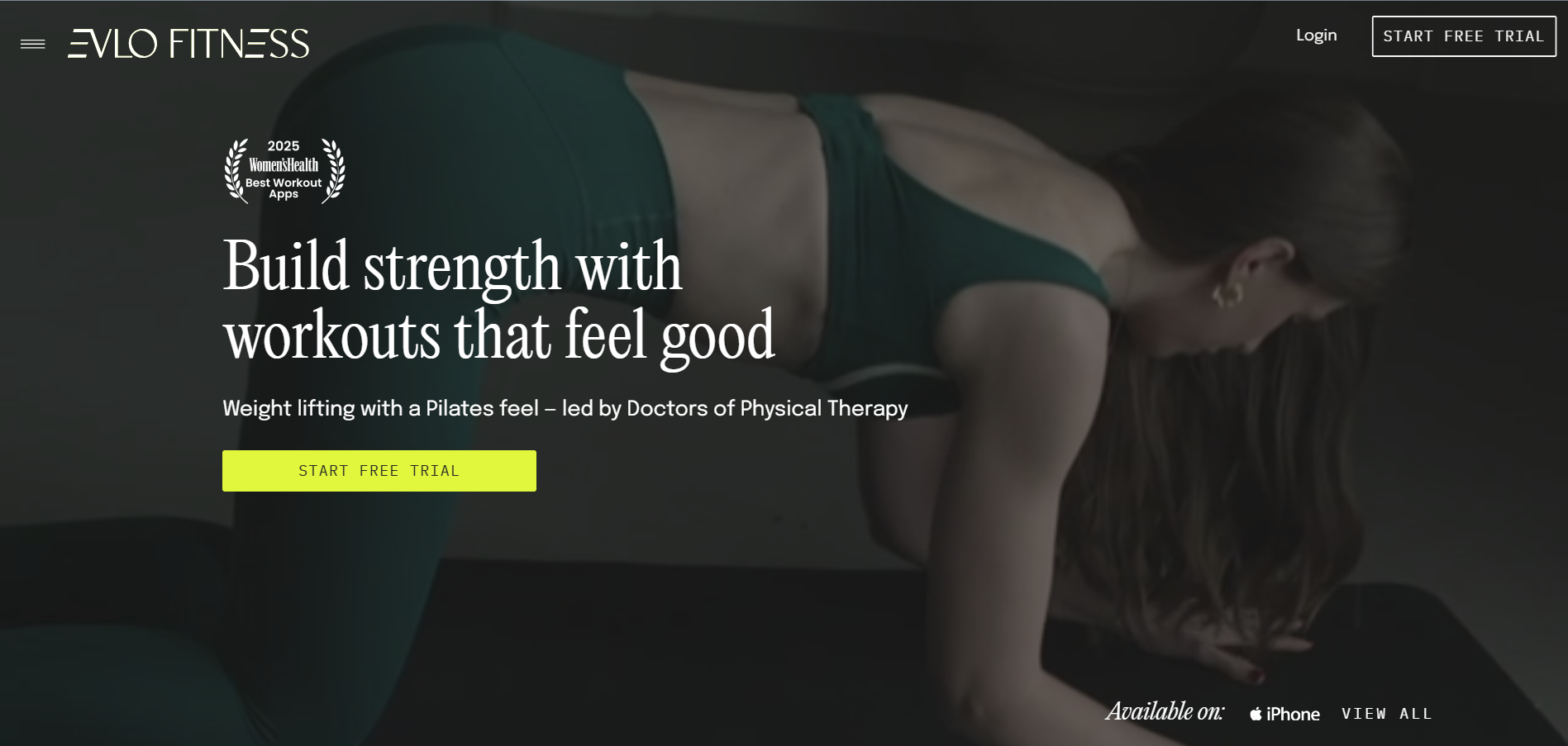
Evlo Fitness offers strength workouts focusing on “gentle consistency”, combining Pilates, barre, yoga, and light cardio guided by physical therapists. The app delivers efficient yet gentle movements designed to build strength without causing soreness or injury, making it ideal for those who need modifications for sensitive areas, such as the back or shoulders.
Features
- Strength training with Pilates, barre, yoga, and cardio elements
- Programs designed to minimize soreness and injury risk
- Exercise modifications for sensitive body areas
- Personalized workout frequency and nutrition plans
- High-definition instructional videos
14. LES MILLS+
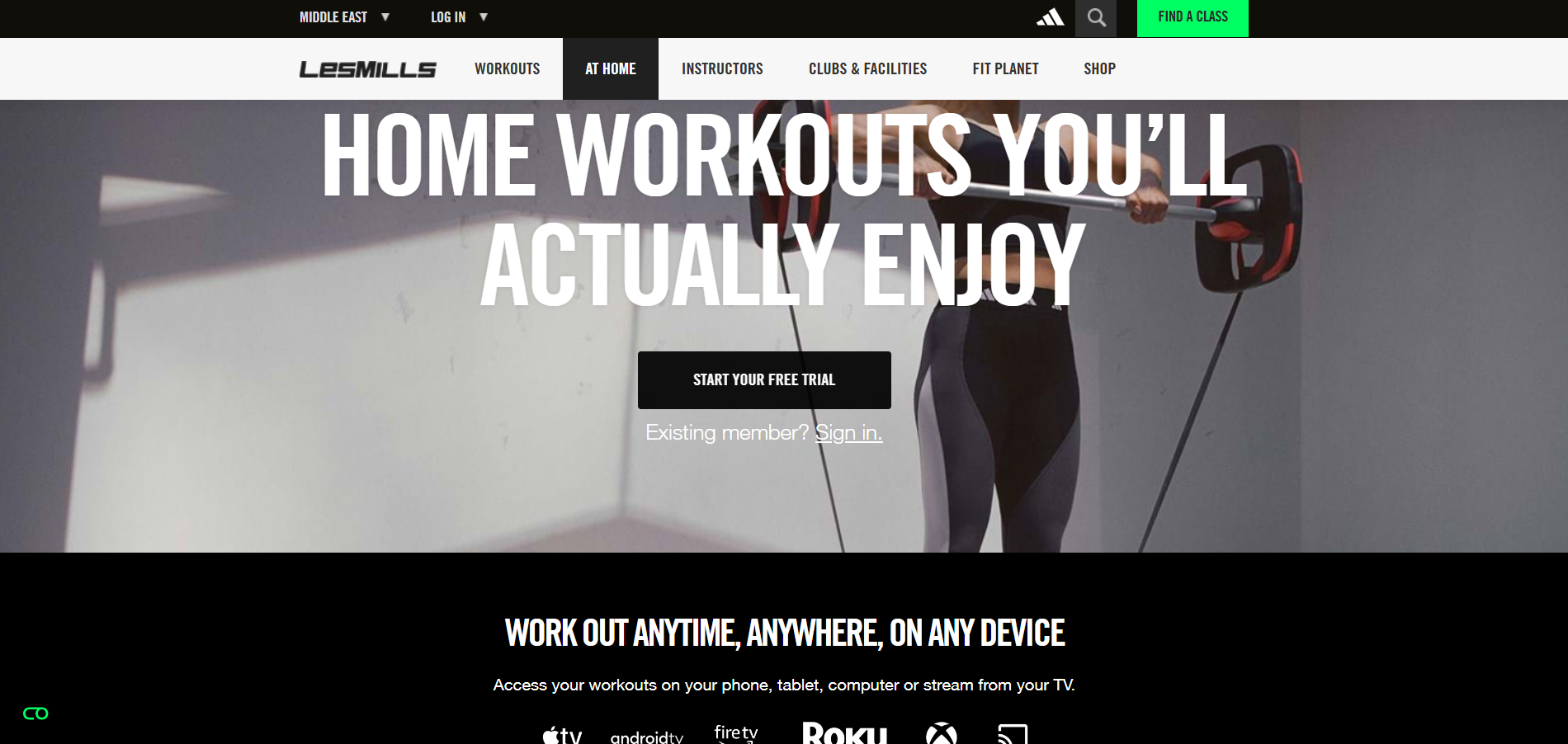
LES MILLS+ features an extensive content library, including strength, cardio, mind-body workouts, and audio-guided runs, with durations from 10 to 55 minutes. It supports all fitness levels with personalized workout suggestions and progress tracking. A standout feature is cycle-syncing workouts, matching training intensity with menstrual cycles. The app brings the energy and motivation of group fitness classes into the comfort of your own home.
Features
- Wide range of workout types and durations
- Personalized recommendations and tracking
- Cycle-syncing workout programs for menstrual cycle alignment
- Motivating coaches and curated music playlists
- Available on Android and iOS
15. Alive

AliVe provides more than 100 daily workouts, over 10 structured programs, and multi-day challenges, suited for all skill levels and equipment types. Trainers like Gabrielle Savary praise the app for its extensive offerings, which target various muscle groups and fitness goals. Alive includes video demonstrations, progress tracking, in-app journaling, and a feature for progress photos.
Features
- Extensive daily workouts and multi-week programs
- Suitable for all equipment setups and skill levels
- Video demos and progress tracking tools
- Community support via Facebook group
- In-app journaling and achievement badges
Who should pick which app?
- Need performance and progressive overload? Prioritize platforms that emphasize strength progression, tracking, and continuity of programming. Look for consistent load progression, clear journaling, and coach feedback paths.
- Want low-impact, sustainable movement? Choose apps that focus on mindful Pilates and mobility cues, offering short sessions that can be stacked across the week for consistent stimulation without flare-ups.
- Crave community and live motivation? Pick apps that pair live classes and real-time metrics with social features; that social anchor keeps harder sessions from skipping.
- These are not arbitrary categories; they reflect how training stress, recovery, and habit formation actually work.
What patterns should you watch for in real usage?
Usage shows clear habits. According to CNET, over 70% of women prefer using workout apps for their fitness routines. In 2025, that preference explains why apps now compete on personalization and user experience rather than just class volume. Also, according to CNET, the average woman spends 45 minutes per day using workout apps. Efficient programming that respects those 45 minutes wins again and again, so favor apps that let you get the stimulus you need in the time you actually have.
A quick buyer checklist you can use right now
- Does the app track and show progressive overload or adaptation?
- Can you get coaching feedback or at least adaptive programming?
- Are sessions time-flexible and easy to compress into 20 to 45 minutes?
- Is data handling and any AI body-scan explained in plain language?
- Does the price deliver measurable outcomes, not just content volume?
What I’d watch for next
Expect the industry to tighten around measurable outcomes and privacy guarantees, because that’s what keeps subscriptions sticky and trust intact.
That’s the practical set-up; what actually proves that these apps change bodies and habits is more complicated than downloads and likes, and that’s what comes next.
Do Workout Apps For Women Really Work?
.jpg)
Yes. Workout apps for women can and do produce measurable fitness improvements when the program supplies progressive overload, clear feedback, and habit design that fits a busy life. Their effectiveness is not magic; it rests on three key factors: the quality of the programming, how the app helps you stay consistent, and whether you track the proper outcomes over weeks, not days.
How do these apps actually create change?
The causal chain is straightforward and predictable: a good app provides a plan that gradually increases stimulus over time, measures whether you follow it, and adjusts based on your progress. In market follow-ups, HTF Market Intelligence reports that 65% of women reported improved fitness levels after using workout apps for three months, indicating that structured stimulus, combined with even modest adherence, produces visible gains within weeks. If the app can translate athlete-level programming into weekly, trackable targets, you will stop guessing and start improving.
Why do people hit plateaus or quit?
This problem affects new users and busy professionals alike: motivation flares, then fades, and the training becomes stagnant. When we coached new users through an 8- to 12-week onboarding process, a pattern emerged: users who completed at least three sessions per week continued to make progress; those who missed multiple weeks lost momentum and reported a decline in strength and confidence. The psychological lift apps can provide, which aligns with findings that Glamour reported that over 70% of women felt more motivated to exercise with the use of workout apps. However, motivation by itself does not replace a program that forces progression and records results.
Most people opt for the familiar approach and stitch together classes or ad hoc workouts because they feel flexible and inexpensive. That works early, but the cost shows up when progress stalls and time is wasted on sessions that do not increase load, reps, or intensity. Solutions like GetFit AI offer athlete-authentic progressive plans and real-time conversational coaching that recalibrate programming when you miss sessions, preserving progression and turning sporadic effort into measurable gains.
What should you measure to know an app is working?
Treat the app like a lab instrument, not a distraction. Track three objective signals over 4 to 12 weeks: adherence, external load (weight or resistance), and performance markers (reps at a given load, time to complete a circuit, or sprint times). Pair those with two subjective signals, perceived exertion and recovery, to spot overreach. If adherence is steady and the load or reps increase, the app is effective; if sessions are frequent but the load remains unchanged, you are spinning your wheels.
Can short, time-efficient sessions build real strength?
Yes, when they are structured for progressive overload and cumulative volume. Think of short sessions as concentrated blocks of stimulus, like stove-top pressure cooking versus slow roasting; both can tenderize, but the mechanism and timing differ. Three focused 20- to 30-minute strength sessions per week, with precise increments in load or rep targets, will increase strength over 8 to 12 weeks because the total weekly volume and progressive stress are what drive adaptation.
What practical habit fixes actually move the needle?
This challenge affects parents, shift workers, and project-driven professionals alike: consistency often breaks down when workouts feel optional. Anchor training to existing habits, schedule sessions as immovable appointments, and use micro-goals for weeks when time is tight. When accountability is the missing piece, choose an app that replaces polite reminders with conversational coaching and adaptive targets that change when life gets messy, so you keep forward momentum without guilt.
It’s frustrating when effort feels wasted, until you start measuring the right things and the numbers tell a different story.
However, the next question reveals the features that distinguish apps that nudge you from those that actually produce results.
Related Reading
- Beginners Workout For Women
- Average Deadlift Weight Kg Woman
- Upper Body Workout For Women
- Leg Day Workout for Women
Features to Consider When Choosing a Workout App For Women
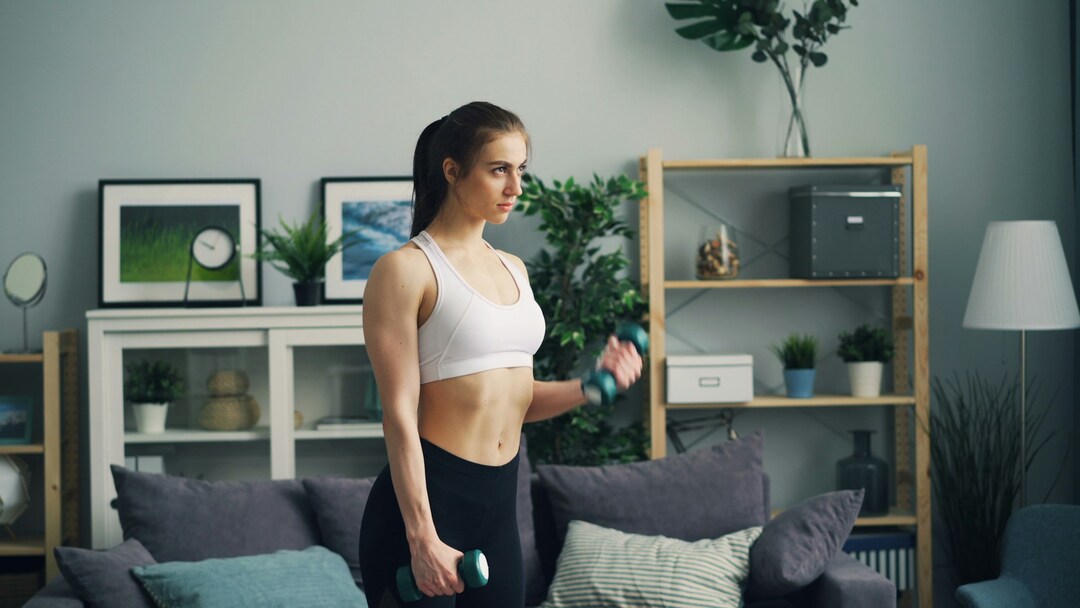
Choose an app that treats your training like an experiment, not entertainment: prioritize tools that give actionable interpretations of your data, predictable habit scaffolding, and precise safety controls so you actually improve week to week. The right features save time, prevent injury, and turn inconsistent sessions into measurable progress.
What does data interpretation look like in practice?
Good apps translate raw numbers into decisions. Instead of a leaderboard of steps, look for automatic summaries that answer questions you would ask a coach, such as whether your weekly load has increased enough to drive strength, whether recovery metrics justify a deload, or which exercises have caused form breakdown. After working on integration projects, a pattern became clear: users stop trusting apps when numbers seem raw or contradictory, and trust returns when the app labels trends, explains causes, and prescribes a single explicit action.
How should onboarding and early wins be designed?
Treat the first four weeks as an outcomes sprint. The app should surface two short wins within 14 days, then lock in progressive targets for the following 4 to 8 weeks. Practical mechanics to look for include guided baseline tests that set realistic starting loads, time-boxed micro-goals for busy weeks, and automated adjustment rules that reduce targets after missed sessions rather than simply pausing progression. This minimizes the churn that comes from vague promises and replaces them with small, confirmable gains.
Which quality-control signals prove an exercise library is trustworthy?
Check for trainer credentials attached to each workout, rep-by-rep technique cues, and multiple camera-angle videos for risky lifts. Prefer libraries that include metadata, such as primary muscle, ordinary regressions, equipment alternatives, and recommended tempo. If an app cannot show why a movement is programmed, treat the content as entertainment, not coaching.
How do safety and real-time feedback work without a coach in the room?
Prioritize apps that combine sensor inputs, short-form video analysis, and simple self-checks. Features I rely on when evaluating safety include automatic rep counting with error flags, fatigue-based rep limits that drop targets when form deteriorates, and in-session prompts for breathing and joint alignment. These are the differences between a workout you survive and a session you actually build on.
Why should you care about integration reliability?
When wearable syncs break or metrics drift, the app’s recommendations become noise. Users frequently describe frustration with intermittent Apple Health or tracker bugs that skew heart-rate zones or step counts, making personalized plans feel arbitrary. The hidden cost is lost confidence, and once confidence erodes, adherence tends to collapse. Platforms such as AI fitness apps centralize integrations, surface sync health, and translate imperfect signals into informed coaching decisions, preserving progression without requiring you to babysit connections.
What about personalization beyond a checkbox?
Real personalization combines constraint-aware programming with decision rules. If your schedule drops to two sessions a week, a good app recalculates weekly volume and focuses on compound strength rather than sprinkling in low-value extras. If sleep and HRV indicate elevated stress, the plan temporarily shifts to a maintenance intensity and recovery focus. These conditional rules are what separate reactive content libraries from programs that actually change bodies.
How to vet privacy, export, and ownership policies fast?
Look for plain-language summaries that tell you what data is stored, where it can be exported, and how long it is retained. Prefer apps that let you export raw workout logs and anonymize biometric traces, because that keeps control with you as needs change. In practice, apps that hide these details generate friction when users try to move on, or when they audit progress with a coach outside the platform.
A practical analogy to test any app quickly
Think of choosing an app like test-driving a car on both city streets and a mountain pass. If the app only performs well under ideal conditions, it will fail when your week gets messy. Insist on features that prove competence under stress: adaptive targets, offline sessions, and clear recovery rules.
Usage trends are changing rapidly; for example, CNET reports that workout app usage among women increased by 30% in 2025. Additionally, CNET finds that the average woman spends 45 minutes per day using workout apps, meaning an app that wastes those minutes will quickly lose users. Combine that reality with the emotion behind stalled progress, the disappointment when a month of effort produces no measurable gain, and you see why these operational features matter more than a polished landing page.
Most people accept shaky integrations and generic plans because they are familiar and friction-free at first. That approach works until data inconsistencies and unclear next steps create a slow leak of motivation and progress. Solutions like an AI fitness app combine athlete-authentic programming with conversational coaching and daily/weekly analysis, protecting progression when life gets messy. This maintains the training effect while saving you time and effort.
Ready to train like the legends and finally achieve the body you've always wanted? GetFit AI's AI fitness trainer app lets you follow the exact workout routines that helped Arnold Schwarzenegger, Kobe Bryant, Cristiano Ronaldo, Serena Williams, and over 11 other elite athletes become champions. You can chat with them whenever you need guidance or motivation. Download the #1 rated AI fitness app for free today to get fit for less than the cost of a single month's gym membership.
That simple promise looks good on paper, but the one thing that changes everything is what happens when life interrupts your plan.
Benefits of Using Workout Apps as a Woman

Workout apps offer women clear, practical advantages: they eliminate scheduling and location barriers, and they translate training into measurable progress that you can act on. Used well, an app turns scattered effort into consistent, progressive stress that produces strength and confidence.
Why does exercising anywhere actually change behavior?
Flexibility is not convenience; it is momentum. When workouts fit into gaps between a school run and a meeting, or while traveling, you stop punishing yourself for missed gym times and you start stacking small, nonnegotiable sessions that accumulate. This pattern appears across busy parents and shift workers: make the workout possible, and adherence rises; make it optional, and weeks slip away. Think of apps like a pocket coach that keeps the session real, even when the schedule doesn't.
How do apps make progress visible instead of vague?
Tracking matters more than inspiration. Good apps record load, reps, and session quality, then translate that into simple trends you can follow week to week. After working through numerous onboarding flows, the consistent failure mode is raw data without direction. The solution is to label trends and provide one explicit follow-up action each week. That simple interpretive layer prevents you from spinning your wheels on workouts that feel hard but do not increase strength.
Are apps actually less expensive than hiring a coach?
Yes, and that cost differential matters for sustained use. The familiar approach is to juggle cheap class packs, occasional trainers, and impulse subscriptions because it feels flexible. The hidden cost is fragmented programming and progress that stalls. Platforms like GetFit AI change that by bundling athlete-authentic programs with conversational coaching, so users get progressive overload and on-demand adjustments for less than the price of a monthly gym membership, keeping results efficient and affordable.
What about community, mental health, and habit support?
Human connection keeps workouts honest. Many women choose apps because they want accountability that fits life, not extra obligations. We see the emotional stakes clearly: frustration builds when devices or unexpected costs interfere, and satisfaction returns when coaching provides a clear plan and delivers short wins. Apps that combine streaks, peer check-ins, and quick recovery tools turn isolated sessions into a durable routine you actually look forward to.
How do personal needs like pregnancy or hormonal cycles get respected?
Personalization must be conditional, not static. If your week is reduced to two sessions, the plan should prioritize compound lifts and volume consolidation. If sleep is poor, intensity should be adjusted accordingly. This conditional logic prevents the all-or-nothing trap where missed weeks erase progress. Platforms that let you adjust goals and auto-recalculate weekly volume keep you on a trajectory that still produces strength gains even when life tightens.
Who is using these tools, and why does that matter?
Women make up nearly 60% of fitness App users. That concentration changes product design, because apps must serve a majority audience who care about privacy, affordability, and practical coaching. When design centers those priorities, engagement and outcomes improve.
What common friction do apps solve compared with hardware-first approaches?
Most people start with a wearable or piecemeal class because those feel complete. The familiar approach is straightforward at first, but as needs grow, costs accumulate, and insights become fragmented. Platforms like GetFit AI provide an alternative path: athlete-sourced programming, adaptive coaching conversations, and progress-tracking that consolidates effort into measurable gains, removing the administrative and financial friction that otherwise erodes momentum.
A quick analogy that clarifies the tradeoff
Think of training like tending a garden. Random classes are seeds scattered across the ground. Athlete-authentic programming is the planned bed, sunlight, and watering schedule that actually grows something. Apps that combine both coaching and measurement act like a gardener who adjusts for drought or pests in real time.
Over 70% of women prefer using workout apps for their fitness routines. That preference explains why thoughtful app design, not just flashy content, now determines whether months of effort become real progress or just good intentions.
That success leaves one nagging question about the cost of convenience and what happens when things go wrong.
Related Reading
- Full Body Workout For Women
- Free Workout Apps For Women
- Workout Routine For Women
- Workout Plans For Women
Cons of Using Workout Apps and How to Overcome Them

Workout apps can amplify real risks for women, from anxiety and pressure to medical blind spots. Still, you can neutralize those harms with attention controls, simple medical screening, and more brilliant goal design. Tackle what the app over-indexes on, not just what it shows you, and you regain control of progress and wellbeing.
How does goal-setting turn helpful into harmful?
When algorithms preset goals without context, they push narrow outcomes that feed comparison and guilt. According to the Centre for Behaviour Change at UCL (2025), 75% of users reported feeling pressured to meet unrealistic fitness goals set by apps. This pressure explains why many users abandon trackers or frequently switch to other apps. Counter that by replacing vanity targets with function-based milestones, for example, timed pushups, a weekly load increase, or consistency streaks tied to real tasks like "play actively with kids for 20 minutes." Make two changes at once: limit the app to one primary objective for eight weeks, and lock secondary aesthetics goals behind explicit consent so the app cannot nudge you toward risky behavior without your permission.
Why do notifications often make things worse?
Notifications are not neutral prompts; they are a persistent cognitive load. Centre for Behaviour Change, UCL, 2025: 60% of users experienced increased anxiety due to the constant notifications and reminders from fitness apps. This is why notification hygiene matters as much as programming. Turn off everything except critical safety alerts, batch coaching nudges into a single daily summary, and set a single weekly check-in that replaces constant micro-reminders. Treat the app like a calendar invite, not a nagging friend, and you stop training from becoming ambient stress.
What about medical and hormonal blind spots that increase injury risk?
Many apps assume a healthy baseline and push intensity without screening. That fails for postpartum bodies, perimenopausal athletes, or anyone with a history of energy deficiency. When we conducted a focused 12-week pilot with clients balancing newborn care and full-time work, the pattern became clear: training plans often break down within three weeks unless the program is recalibrated to account for sleep, breastfeeding, and pelvic floor recovery.
Require at-home screening questions before high-intensity programs, insist on clinician-verified regressions for common red flags, and use autoregulation methods like rate of perceived exertion and two-rep buffer rules so workload scales with daily capacity. Those steps protect progress while preserving training stimulus.
When tracking feeds obsession, how do you stop it?
Excess metrics can encourage micromanagement and unhealthy comparison. The fix is deliberate metric minimalism. Pick one objective progress metric, for example, weekly cumulative load or a single strength test, and one wellbeing metric like sleep quality or perceived recovery: archive or mute vanity stats for a month. Schedule a monthly review session with a friend or coach to interpret data together, so numbers become conversation fuel rather than a private scoreboard you endlessly refresh.
Are privacy and downstream data use real risks?
Yes. Biometric traces and workout histories are valuable to advertisers and insurers. Demand exportability and deletion tools, and use pseudonymous accounts when testing features that ask for sensitive data. If an app requires body scans or continuous HRV, verify where the data is stored, how long it is retained, and whether it can be exported in a human-readable format. Those are not neat technicalities; they are safeguards that let you walk away without leaving personal health fingerprints behind.
Most people handle these problems by tweaking settings and hoping for the best, because it is familiar and requires no new workflow. That approach masks a hidden cost: incremental anxiety, creeping risk, and progress that feels expensive emotionally. Solutions like GetFit AI change that by combining athlete-authentic programming with conversational coaching that can pause progression, reroute goals, and automatically quiet notifications when stress or medical flags appear, preserving gains without turning training into a pressure cooker.
How do you make fixes that actually stick in daily life?
Treat fixes as constraints, not chores. Use a 14-day experiment: reduce tracked metrics to two, mute notifications except for the daily summary, and run a conservative autoregulation rule that reduces the planned load by 15 percent after two consecutive poor-recovery days. If adherence improves and anxiety drops within those two weeks, keep the settings and push the load slowly. Think of these changes like pruning a plant, removing what is crowding the growth, then water deliberately.
That one problem nobody talks about is how the idea of elite-level training collides with the messy realities of life, and the next section peels back exactly how that tension can be resolved.
Make Your Favorite Athlete Your Fitness Trainer | Try GetFit AI's AI Trainer App for Free Today
Suppose you want athlete-level programming that actually adapts to the equipment you own and the unpredictability of real life. In that case, we should try GetFit AI, as stitching together classes and random plans wastes time and stalls progress. Join the community behind over 1 million downloads and the app's 90% user satisfaction rate, and see whether conversational coaching and equipment-aware plans turn short sessions into steady, measurable gains.
Related Reading
- Lower Abs Workout for Women
- Arms Workout for Women
- Hiit Workout Women
- Ab Workout Women




.png)











